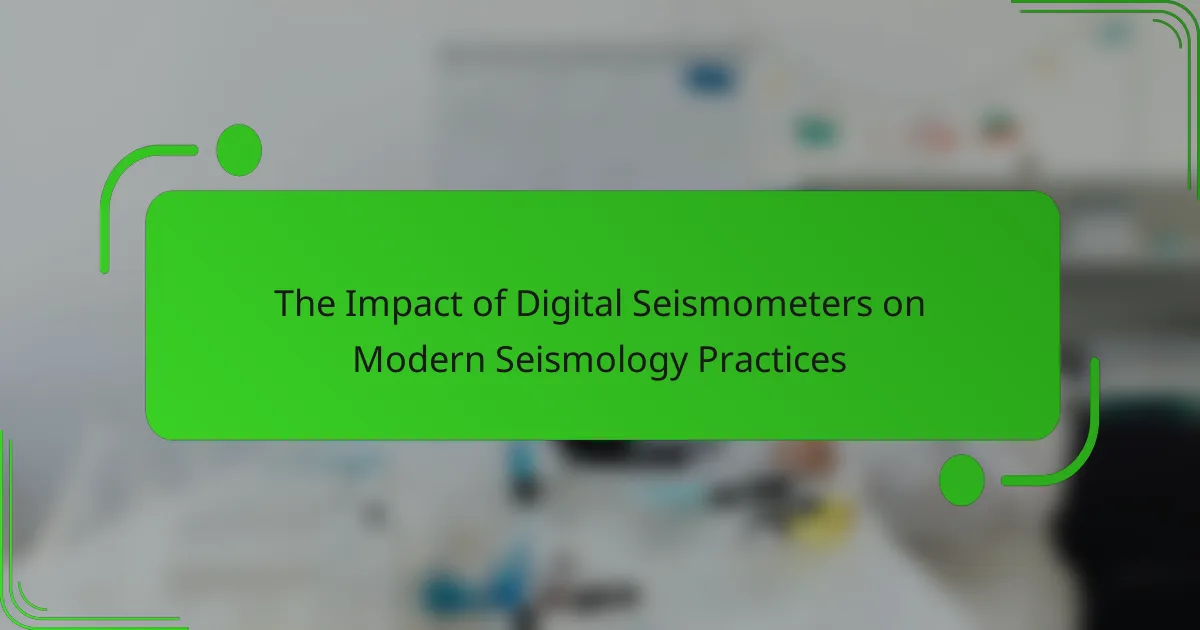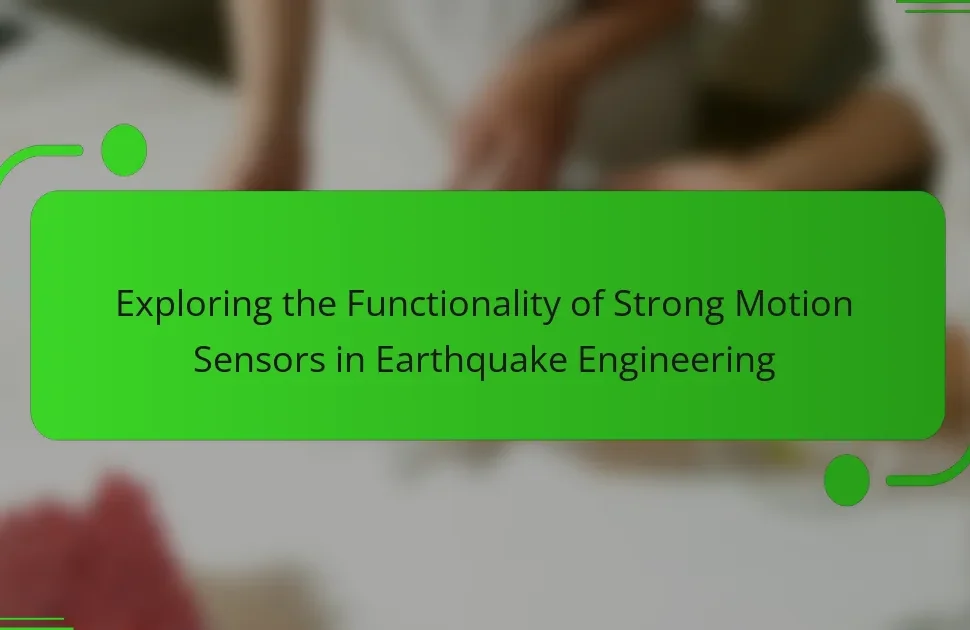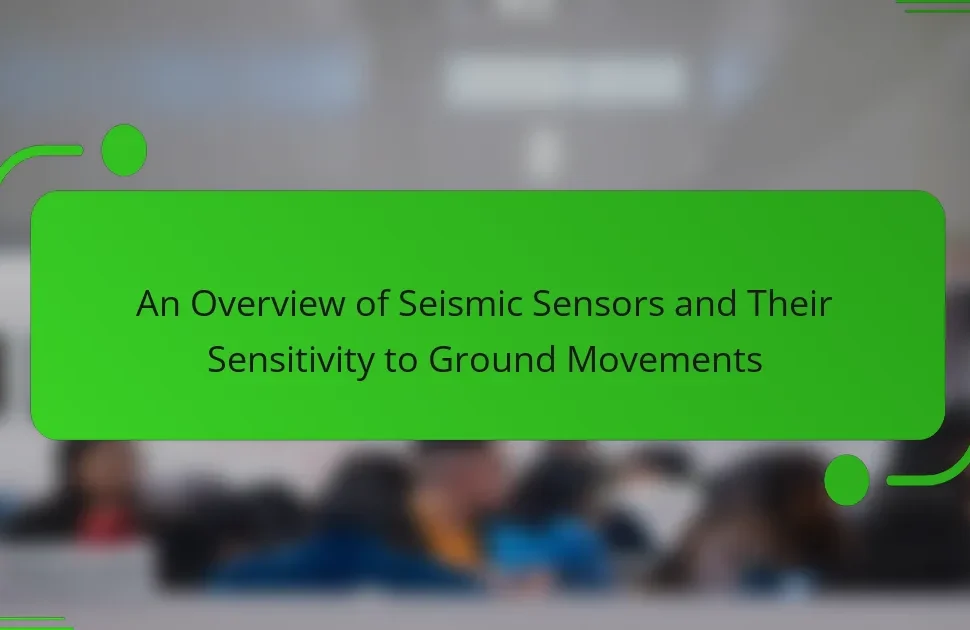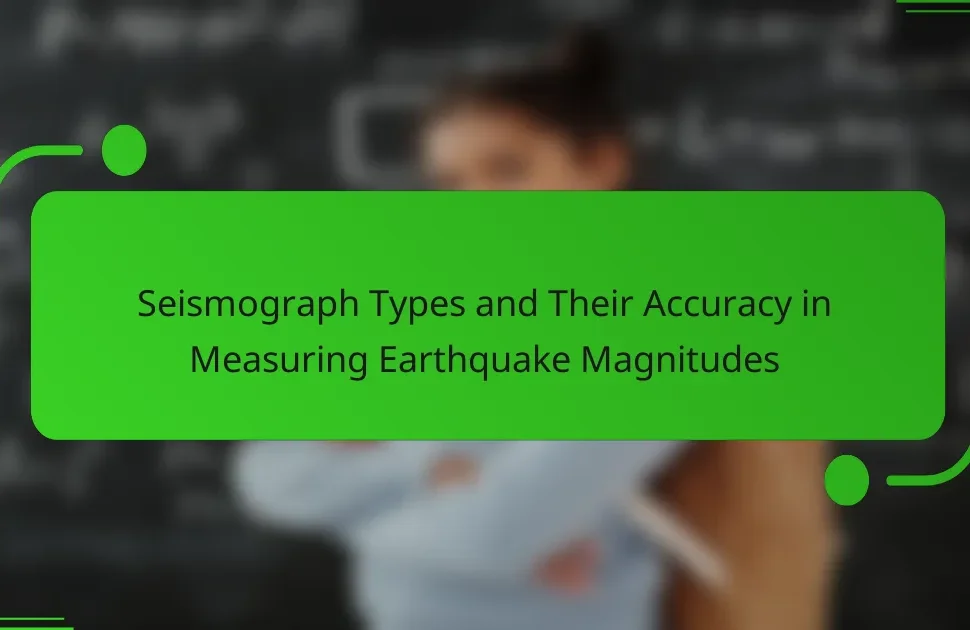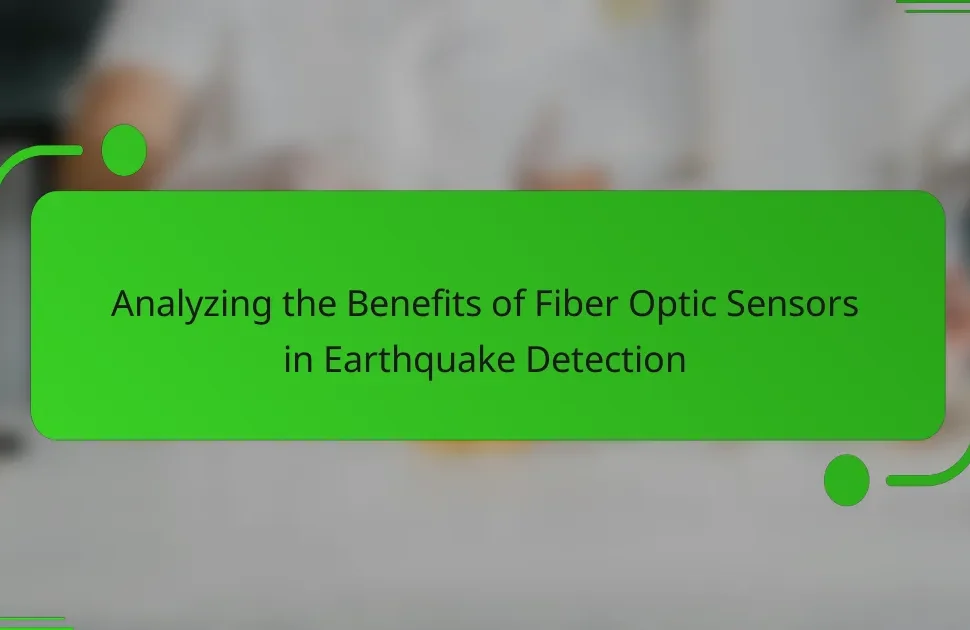Digital seismometers are advanced instruments that measure ground motion resulting from seismic waves, converting mechanical vibrations into electrical signals for accurate data analysis. They significantly enhance earthquake detection and characterization by capturing a broader frequency range and enabling real-time data transmission. This technology improves seismic monitoring and supports advanced processing techniques for better interpretation of complex data. However, digital seismometers face challenges such as environmental noise interference, power supply issues, calibration difficulties, data storage limitations, connectivity problems, and vulnerability to extreme weather conditions, all of which can affect the reliability of seismic readings. The integration of digital seismometers has transformed modern seismology practices, leading to more effective earthquake monitoring systems and improved public safety through enhanced early warning capabilities.
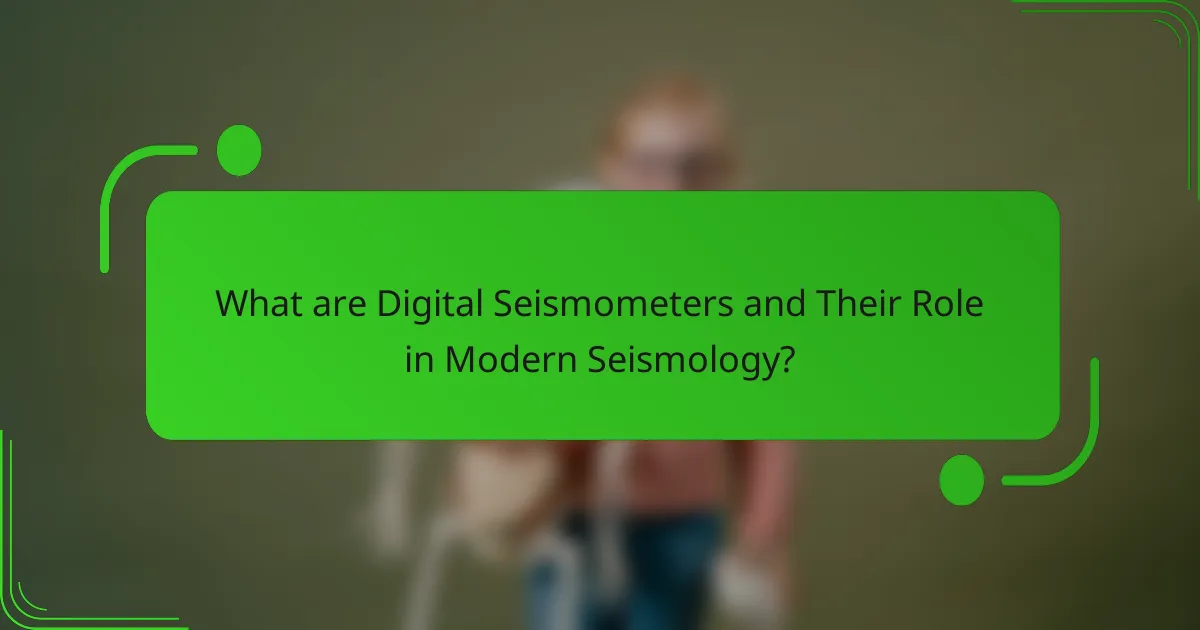
What are Digital Seismometers and Their Role in Modern Seismology?
Digital seismometers are advanced instruments that measure ground motion caused by seismic waves. They convert mechanical vibrations into electrical signals for precise data analysis. These devices enhance the accuracy of earthquake detection and characterization. Digital seismometers can capture a wider frequency range than traditional analog models. They provide real-time data transmission, facilitating immediate analysis. This technology allows for improved monitoring of seismic activity. Digital seismometers play a crucial role in understanding earthquake mechanics and assessing risks. Their deployment has significantly advanced the field of modern seismology.
How do Digital Seismometers differ from Traditional Seismometers?
Digital seismometers differ from traditional seismometers primarily in data acquisition and processing methods. Digital seismometers convert seismic waves into digital signals for precise analysis. They offer higher sensitivity and wider frequency ranges compared to their analog counterparts. Traditional seismometers often use mechanical components that can limit performance. Digital systems provide real-time data transmission and remote monitoring capabilities. This allows for quicker response times during seismic events. Additionally, digital seismometers can store large amounts of data for further analysis. Research indicates that digital technology enhances detection of smaller earthquakes and improves overall seismic monitoring accuracy.
What technological advancements are found in Digital Seismometers?
Digital seismometers incorporate advanced technologies such as high-resolution sensors and digital signal processing. These sensors enhance sensitivity and accuracy in detecting seismic waves. Digital signal processing allows for real-time data analysis and improved signal clarity. Many digital seismometers utilize broadband sensors that capture a wide frequency range. This capability enables the detection of both local and distant seismic events. Additionally, advancements in data storage technology facilitate the handling of large datasets. Enhanced communication technologies enable remote monitoring and data transmission. These innovations significantly improve the efficiency and reliability of seismic monitoring systems.
How do these advancements improve data accuracy and reliability?
Advancements in digital seismometers significantly improve data accuracy and reliability. These instruments provide higher resolution measurements of seismic waves. Enhanced sensitivity allows for the detection of smaller tremors that traditional seismometers might miss. Digital processing techniques reduce noise and enhance signal clarity. Real-time data transmission ensures timely access to seismic information. Improved calibration methods increase the precision of measurements. Advanced algorithms analyze data more effectively, leading to better interpretations. According to a study by the United States Geological Survey, the integration of digital technology has resulted in a 30% increase in data quality in seismic monitoring.
What are the key features of Digital Seismometers?
Digital seismometers are advanced instruments used to detect and record seismic waves. They offer high sensitivity and accuracy in measuring ground motion. Digital seismometers convert analog signals into digital data for enhanced analysis. They feature a wide dynamic range, allowing them to capture both small and large seismic events. These instruments often include built-in data storage and transmission capabilities. Many digital seismometers are equipped with GPS synchronization for precise timing. They can operate over a broad frequency range, making them suitable for various seismic studies. Digital seismometers also support real-time monitoring and data sharing, improving response times during seismic events.
What types of sensors are used in Digital Seismometers?
Digital seismometers primarily use three types of sensors: accelerometers, geophones, and broadband sensors. Accelerometers measure ground acceleration and are sensitive to high-frequency seismic waves. Geophones convert ground motion into electrical signals and are commonly used in oil exploration. Broadband sensors can detect a wide range of frequencies, making them suitable for various seismic studies. Each type of sensor plays a crucial role in capturing different aspects of seismic activity. Their combined use enhances the accuracy and reliability of seismic data collection.
How does data processing work in Digital Seismometers?
Digital seismometers process data by converting ground motion into electrical signals. These devices utilize accelerometers or geophones to detect vibrations. The electrical signals generated are digitized for analysis. Digital signal processing algorithms filter and enhance the data. This process improves signal clarity and reduces noise. The processed data is then stored for further analysis. Researchers can interpret this data to identify seismic events. Digital seismometers provide real-time data, enhancing monitoring capabilities.
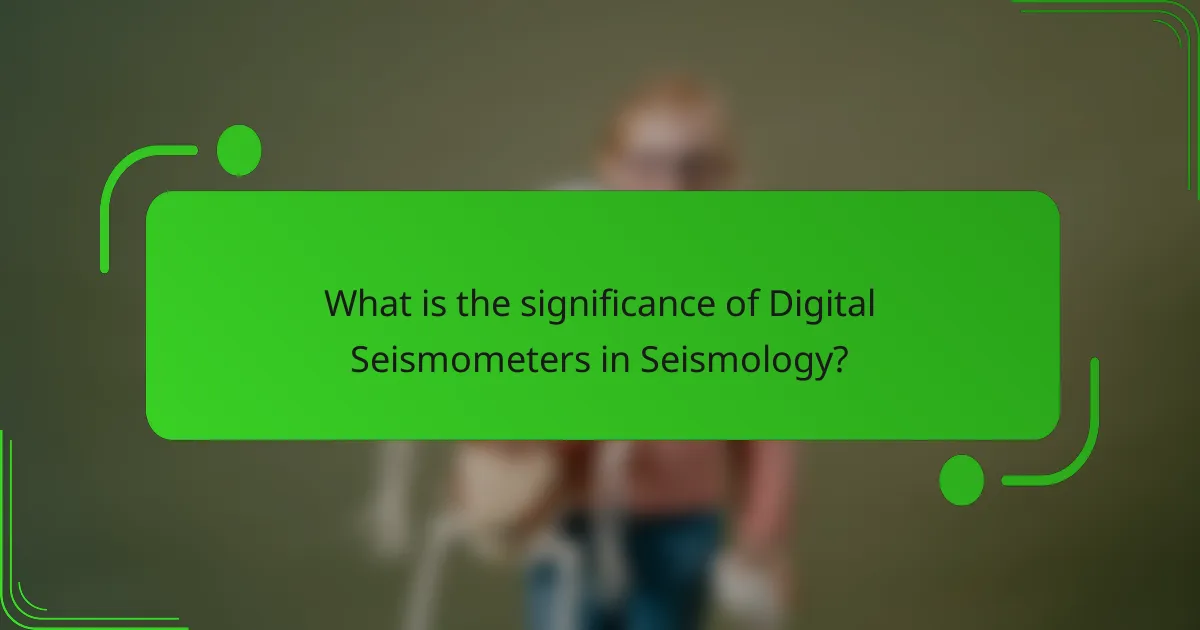
What is the significance of Digital Seismometers in Seismology?
Digital seismometers are crucial in seismology as they provide precise measurements of ground motion. They enhance data accuracy by capturing seismic waves with high fidelity. This precision allows for better analysis of earthquake characteristics. Digital seismometers also facilitate real-time data transmission. This capability enables immediate response during seismic events. Furthermore, they support advanced processing techniques. These techniques improve the interpretation of complex seismic data. The integration of digital seismometers has significantly advanced earthquake monitoring systems worldwide. Their deployment has led to more effective early warning systems, thereby increasing public safety.
How have Digital Seismometers transformed earthquake monitoring?
Digital seismometers have significantly transformed earthquake monitoring by enhancing data accuracy and real-time analysis. They utilize advanced digital technology, leading to improved sensitivity in detecting seismic waves. This allows for the identification of smaller earthquakes that were previously undetectable. Digital seismometers also provide high-resolution data, enabling detailed analysis of seismic events. They facilitate automated data collection and processing, which streamlines research and response efforts. Furthermore, they enable remote monitoring, allowing scientists to observe seismic activity from various locations. The integration of digital seismometers has led to better early warning systems, potentially saving lives and reducing damage during earthquakes.
What improvements have been made in real-time data collection?
Recent advancements in real-time data collection for seismology include enhanced sensor technology and data transmission methods. Digital seismometers now provide higher sensitivity and accuracy, enabling the detection of smaller seismic events. Improved algorithms allow for faster data processing and analysis, facilitating quicker response times during seismic events. Advances in wireless communication have enabled remote data transmission, reducing latency in data availability. Cloud computing resources support large-scale data storage and analysis, improving accessibility for researchers. These improvements collectively enhance the ability to monitor seismic activity in real-time, leading to better earthquake preparedness and response strategies.
How do Digital Seismometers enhance seismic event analysis?
Digital seismometers enhance seismic event analysis by providing high-resolution data. They capture seismic waves with greater accuracy than traditional analog instruments. This allows for detailed analysis of earthquake characteristics. Digital seismometers have faster sampling rates, often exceeding 1000 samples per second. This high frequency helps detect smaller seismic events that would be missed otherwise. Additionally, they offer improved signal processing capabilities. Digital data can be easily stored and transmitted for remote analysis. The integration of GPS technology in digital seismometers enhances location accuracy. Overall, these advancements lead to better understanding and prediction of seismic events.
What are the benefits of using Digital Seismometers in research?
Digital seismometers provide enhanced accuracy and sensitivity in seismic research. They measure ground motion with high precision. This leads to better detection of small earthquakes. Digital seismometers also offer real-time data transmission. This allows researchers to analyze seismic events as they occur. Additionally, they have a wider frequency response compared to analog devices. This enables the capture of a broader range of seismic waves. Furthermore, digital seismometers facilitate advanced data processing techniques. These techniques improve the interpretation of seismic data. Overall, digital seismometers significantly advance the field of seismology.
How do they contribute to understanding tectonic movements?
Digital seismometers contribute to understanding tectonic movements by providing precise measurements of ground motion. They detect and record seismic waves generated by tectonic activities. This data helps scientists analyze the behavior of tectonic plates. Digital seismometers offer higher sensitivity and accuracy compared to traditional models. They enable the identification of smaller earthquakes that may indicate tectonic shifts. The real-time data allows for immediate analysis and response. Research shows that enhanced data collection improves models of tectonic processes. This leads to better predictions of seismic events and understanding of fault lines.
What role do they play in hazard assessment and mitigation?
Digital seismometers play a critical role in hazard assessment and mitigation. They provide real-time data on seismic activity, which is essential for understanding earthquake risks. This data helps scientists analyze the magnitude, depth, and location of earthquakes. Accurate measurements enhance the ability to predict potential impacts on infrastructure and populations. Digital seismometers also contribute to early warning systems. These systems can alert communities seconds before shaking occurs, potentially saving lives. The integration of digital seismometers into monitoring networks improves data collection efficiency. This advancement facilitates more informed decision-making in emergency preparedness and response strategies.
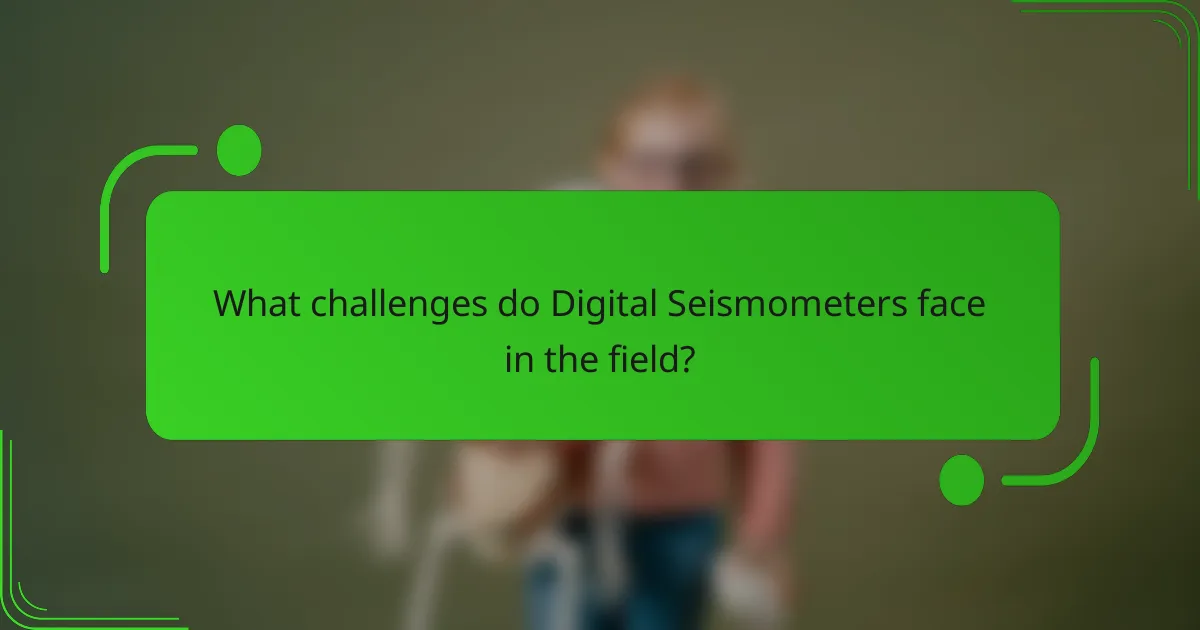
What challenges do Digital Seismometers face in the field?
Digital seismometers face several challenges in the field. These challenges include environmental noise interference, which can distort data accuracy. Additionally, power supply issues can hinder their operation in remote locations. Calibration difficulties may arise, affecting measurement precision. Data storage limitations can restrict the amount of information collected. Connectivity problems can impede real-time data transmission. Lastly, extreme weather conditions can damage equipment or disrupt functionality. Each of these factors can significantly impact the reliability of seismic readings.
What are the limitations of current Digital Seismometer technology?
Current digital seismometer technology has several limitations. One major limitation is sensitivity to noise, which can affect data accuracy. Environmental factors, such as wind or traffic, contribute to this noise. Another limitation is the dynamic range, which can restrict the detection of very small or very large seismic events. Additionally, digital seismometers often require calibration and maintenance, which can be resource-intensive. Their reliance on power sources makes them vulnerable during power outages. Moreover, data processing capabilities can lag behind the speed of seismic events, leading to delays in analysis. Finally, high costs can limit accessibility for smaller research institutions. These limitations can hinder the effectiveness of digital seismometers in modern seismology practices.
How do environmental factors affect Digital Seismometer performance?
Environmental factors significantly impact Digital Seismometer performance. Temperature variations can affect sensor sensitivity and calibration. High humidity levels may introduce noise into the data collected. Additionally, vibrations from nearby construction or traffic can interfere with readings. Dust and particulate matter can obstruct sensor components, leading to inaccuracies. The presence of electromagnetic interference from power lines or electronic devices can distort signals. Altitude and geographical location influence the seismic background noise levels. These factors must be considered during installation and operation for accurate data collection.
What are the common technical issues encountered?
Common technical issues encountered with digital seismometers include data loss, calibration errors, and power supply failures. Data loss can occur due to network interruptions or storage limitations. Calibration errors may arise from environmental factors or improper setup. Power supply failures can lead to system downtime, affecting data collection. These issues can compromise the accuracy and reliability of seismic measurements. Regular maintenance and updates are essential to mitigate these challenges.
How can researchers and practitioners optimize the use of Digital Seismometers?
Researchers and practitioners can optimize the use of digital seismometers by ensuring proper calibration and maintenance. Regular calibration enhances measurement accuracy. Practitioners should also utilize advanced data processing techniques. These techniques improve signal-to-noise ratios and data interpretation. Implementing real-time data transmission increases accessibility for analysis. Additionally, integrating machine learning algorithms can enhance event detection capabilities. Training personnel on the latest technology ensures effective usage. Collaboration among institutions fosters data sharing and collective advancements. These strategies collectively enhance the efficacy of digital seismometers in seismology.
What best practices should be followed for installation and maintenance?
Best practices for installation and maintenance of digital seismometers include ensuring proper site selection and preparation. The installation location should minimize noise from human activities and environmental factors. Ground conditions must be assessed for stability, and the seismometer should be anchored securely. Regular calibration is essential to maintain accuracy; this should be performed according to manufacturer guidelines. Maintenance checks should occur at scheduled intervals to inspect for any physical damage or wear. Data integrity should be verified routinely to ensure reliable readings. Environmental factors, such as temperature and humidity, should be monitored as they can affect performance. Following these practices enhances the reliability and accuracy of seismic data collected.
How can data interpretation be improved for better insights?
Data interpretation can be improved for better insights by utilizing advanced analytical techniques. Techniques such as machine learning and data mining can enhance pattern recognition. These methods allow for the identification of subtle trends that traditional analysis might miss. Visualization tools can also aid in presenting complex data clearly. This clarity helps stakeholders understand the implications of the data. Collaboration among interdisciplinary teams fosters diverse perspectives on data interpretation. Regular training on new technologies and methodologies keeps analysts updated. Research shows that organizations using these strategies achieve higher accuracy in insights. For instance, a study by the National Earthquake Information Center highlights improved predictive models through enhanced data interpretation methods.
Digital seismometers are advanced instruments that measure ground motion caused by seismic waves, significantly enhancing the accuracy and efficiency of modern seismology practices. This article explores the differences between digital and traditional seismometers, highlighting technological advancements such as high-resolution sensors and real-time data processing that improve data accuracy and reliability. It also examines the key features, types of sensors, and the role of digital seismometers in understanding tectonic movements, hazard assessment, and earthquake monitoring. Furthermore, the article addresses challenges faced by digital seismometers and best practices for optimizing their use in research and data interpretation.
